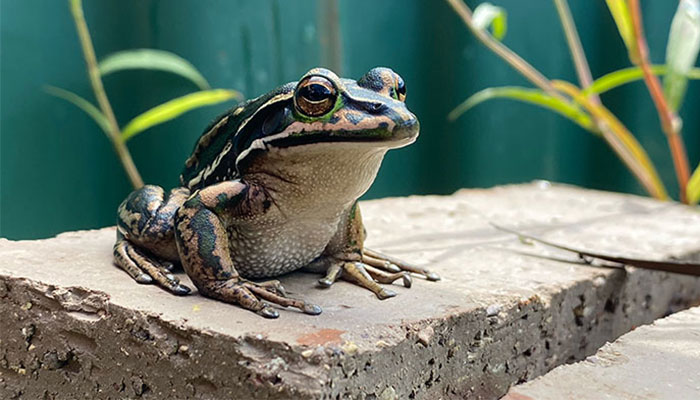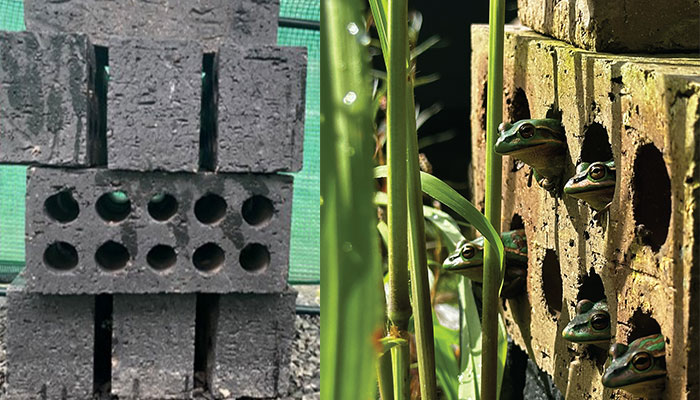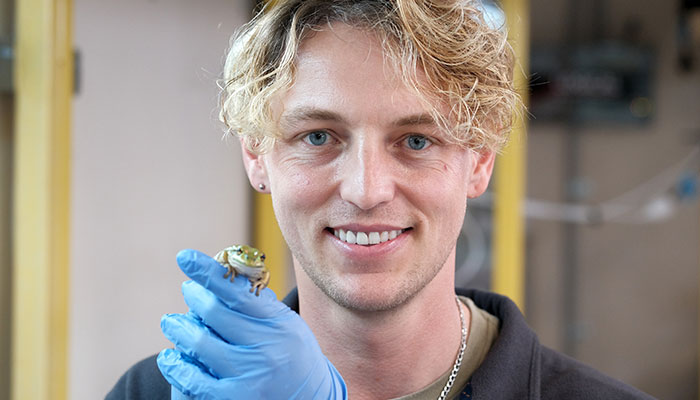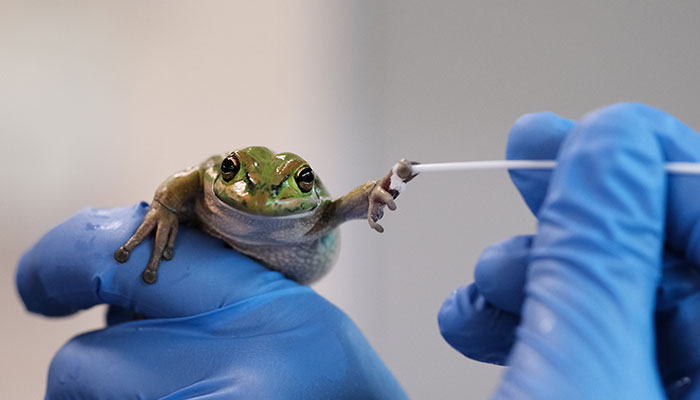Macquarie University researchers have used heat to develop a simple and effective way to help endangered frogs avoid the catastrophic impact of a pandemic sweeping multiple species.

Under threat: Green and golden bell frogs are vulnerable to a deadly fungal infection that has seen their numbers plummet in Australia. Photo: Dr Athony Waddle
In collaboration with the University of Melbourne, researchers targetted the fungal disease chytridiomycosis, which has already driven at least six species of amphibians to extinction in Australia, and threatens dozens more worldwide.
The findings, published in the journal Nature, offer a potential lifeline for rapidly declining populations such as the green and golden bell frog (Litoria aurea), which has disappeared from more than 90 per cent of its native range in Australia since the disease arrived from the Korean Peninsula in 1978.
Dr Anthony Waddle, a Schmidt Science Fellow at Macquarie University’s Applied BioSciences and lead author of the study, says very few interventions address the impact of the international spread of the disease-causing chytridiomycosis fungus (Batrachochytrium dendrobatidis or Bd).
“In the 25 years since chytridiomycosis was identified as a major cause of the global collapse of amphibian populations, our results are the first to provide a simple, inexpensive and widely applicable strategy to buffer frogs against this disease,” Dr Waddle says.
In these simple little hot spots, frogs can go and heat up their bodies to a temperature that destroys the infections.
Chytridiomycosis typically establishes itself permanently once it spreads to a new environment, and has caused greater damage to global biodiversity than any other recorded disease or invasive species.
Of chytridiomycosis-affected species worldwide, 90 have become extinct or are presumed extinct in the wild. Another 124 species have declined in number by more than 90 per cent.
Senior author Professor Rick Shine, from Macquarie University’s School of Natural Sciences, says this study has demonstrated a simple intervention which can easily scale up, potentially helping reduce the impact of the deadly pandemic.
“Chytrid isn’t going away, but our behavioural ecology intervention can help endangered amphibians co-exist with chytridiomycosis in their ecosystems,” Professor Shine says.
Mini med spa for frogs
The research team found providing artificial ‘hot spot’ shelters allows frogs to quickly “bake off” infections.
The team built small shelters from readily available materials, such as bricks and PVC greenhouses, so frogs could regulate their body temperature and live in conditions that suppress the growth of the fungal pathogen.

Simple and successful: Dr Waddle’s team used bricks placed in sunny spots to provide hot shelters for green and golden bell frogs, pictured above, dubbing the experimental method as “mini med spas for frogs”. Photo: Dr Anthony Waddle
Green and golden bell frogs naturally prefer temperatures around 29 degrees Celsius, which is much higher than the chytridiomycosis fungus can tolerate, Dr Waddle says.
The research found when frogs shifted to hot spot shelters, infections were reduced significantly, and frogs that cured their infections with heat were then immune to subsequent infections.
“The whole thing is like a mini med spa for frogs,” says Dr Waddle.
“In these simple little hotspots, frogs can go and heat up their bodies to a temperature that destroys the infections.
“As with many human diseases, such as influenza, chytridiomycosis is seasonal. Winter is a particularly vulnerable time for frogs, given there are few opportunities to heat themselves up.
“By making hot spots available to frogs in winter, we empower them to cure their infections, or not even get sick at all.”
Attractive habitats
A critical factor in the project was creating habitats that frogs would actively seek out and use, Dr Waddle says.
“Getting the mix of shade and heat right is really important, because there’s little point having hotspots available in nature if the frogs don’t use them,” Dr Waddle says.
The simple prototypes – a pile of bricks inside a greenhouse – proved to be a secure and attractive place for frogs to gather.
We’ve shown that it works; now we’re putting it into one of the most vulnerable populations where we expect to see immediate impact.
To test the effectiveness of the hot spot shelters in a more realistic setting, the team conducted a 15-week research project using the outdoor experiment technique known as ‘mesocosms’, which are designed to mimic the frogs’ natural habitat.
Inside thermal shelters, the maximum daily temperature was about 4.5 degrees Celsius higher in shelters exposed to direct sunlight compared to those that were shaded.
The results showed that frogs infected with chytridiomycosis shake off the infection faster when they can warm up in unshaded shelters, compared to shaded ones.
Survivor populations
The study also showed frogs who survive an infection can develop a form of acquired immunity, making them more resistant to future infections.

Innovators: Dr Anthony Waddle, pictured above, led a team of researchers who are the first to provide a simple, and widely applicable strategy for frogs to fight off the deadly chytridiomycosis fungal infection. Photo: Yorick Lambreghts
When re-exposed to the fungus, these “pathogen-experienced” frogs had a much higher survival rate (86 per cent) compared with frogs which hadn’t been previously infected (22 per cent). They also exhibited lower infection levels overall.
“Lowering mortality rates and boosting their immunity to chytridiomycosis is the key to protecting amphibians from this disease, which is now endemic around the world,” says Dr Waddle.
Chytridiomycosis is native to the Korean Peninsula but has devastated frogs outside this area because they have no natural protection.
Dr Waddle says these simple hot spot shelters are easy to reproduce, and the strategy can easily be scaled up with community involvement.
“Our study used green and golden bell frogs, which used to be very common across eastern Australia; they lived in letterboxes and backyards and really adapted to human settlements, before chytridiomycosis came and hammered the population,” Dr Waddle says.

Swab: Dr Waddle’s results showed frogs who survived a chytridiomycosis infection can also develop a form of acquired immunity, making them more resistant to future infections. Photo: Yorick Lambreghts
The research team is now working on expanding the study and implementing the hotspot shelters in one of the largest and most vulnerable populations of green and golden bell frogs, at Sydney Olympic Park.
“We’ve shown that it works; now we’re putting it into one of the most vulnerable populations where we expect to see immediate impact,” says Dr Waddle.
Dr Anthony Waddle is a a Schmidt Science Fellow at Macquarie University’s Applied BioSciences in the Faculty of Science and Engineering.







